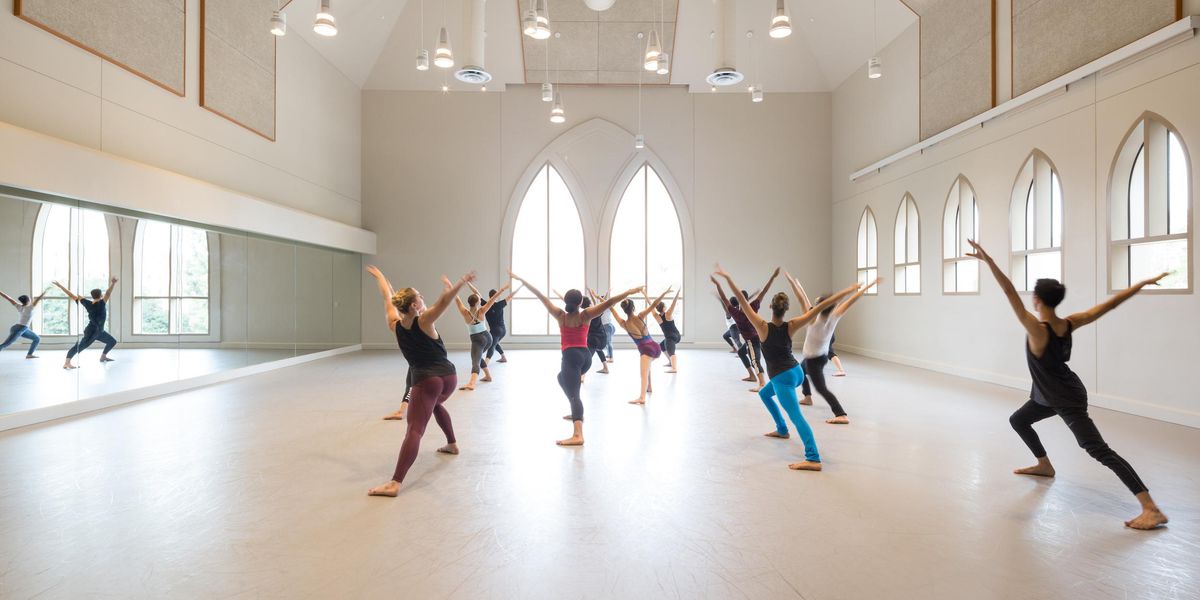2015 Summer Study Guide: Bournonville with a Twist
Danish Dance Masters brings Bournonville to a new generation of American dancers.
Mogens Boesen with dancer Emily Abrom at a Danish Dance Masters audition. Photo by Flemming Enevold, Courtesy Danish Dance Masters.
In a studio of teenagers, Nikolaj Hübbe sits on the floor, legs in a straddle, dramatically perfecting a fifth position of a student. “Speak, talk to me,” he whispers loudly to the student’s foot, as he patiently waits for her to pas de cheval. “No, try again, as if God was in the detail. Shape yourself.” He places the student’s hand on his shaggy blonde head for balance. Hübbe, artistic director of the Royal Danish Ballet and former New York City Ballet principal, is interested in building a foundation, working this pre-professional class at Danish Dance Masters from the ground up. As the presentation and articulation of the foot becomes more precise, he moves up the body. “Okay, you were good down here, but now it is the performing arts,” he says. “The arm is there to frame and underline.” He partners, he demonstrates, he sings and he stops them constantly, sometimes just as the group begins a combination. “I’m here to push—you can’t let young people off the hook. But you have to have a good time in anything creative. There has to also be a light-heartedness,” explains Hübbe, clearly a big kid at heart himself and loving every minute of teaching this ballet class infused with Bournonville technique.
The two-week intensive, held for the first time in 2014 at the Alvin Ailey studios in New York City, accepts around 20 pre-professional dancers, ages 15 and up. From an open audition and videos, the small group is chosen on the basis of strength and passion. They’re taught daily ballet classes by Linda Hindberg, former principal dancer with RDB, and Mogens Boesen, former dancer and current teacher at RDB, as well as Graham technique by former Martha Graham School director Marianne Bachmann. In addition, there are classes in pointe, variations and Pilates. “The Graham and Bournonville are a good match because they share the same sense of weight, travel, direction and channeling of emotion through movement. It is often hard for ballet dancers to get grounded in their pelvises,” says Bachmann, “and practicing the Graham technique can help them get out of trying to move from their extremities.” In addition, Hübbe, who is a guest teacher, and the faculty offer two promising students the chance to travel to RDB at the end of the program to train with the company.
“We wanted to share our history and tradition—which produces good dancers and jumpers—and place it directly in the students’ hands,” says Hindberg. Since story ballets are the basis of the Bournonville repertoire, the Danish Dance Masters program strives not only to clarify the how of these fundamental techniques but also the why. “In America, we are so focused on legs,” says Hübbe, “and I love the American leg, but it is the back, the shoulders, the thoracic region and the arms connecting to all of it that need work, too.” To that end, there is as much spotlight on the precision and clarity of the port de bras as there is focus on the use of the foot and plié that makes for such world-renowned allégro.
For Emily Abrom, an 18-year-old originally from Lancaster, Pennsylvania, who currently trains with Nadege Hottier, a teacher of the French style in New York City, the unparalleled individual attention Danish Dance Masters offered was a surprise. “We were each given a solo so we could develop our performance quality,” she says. “That is rare!” While many summer programs offer variations classes, few offer this level of personal coaching, a huge boon to advanced students. The program seeks to draw personalities out through the selection of a specific Bournonville solo for each student that is performed in an informal showing on the last day. They are coached to find their own story or pictures within the choreography. “The steps have to have a higher purpose in order to transform into art and involve the audience,” says Hindberg. “The students have to learn how to keep the joy and images moving from them to us, even when the steps get hard.”
While Abrom had never done Graham before and only had a brief prior experience with Bournonville, she credits the new techniques and small environment with changing her work ethic and focus. “It has been a lab where I can actually fix my bad habits and bring more meaning and expression into my work. I am realizing how much more forward I need to be on my feet in order to move faster, and how much more presentation is required in performance,” she says.
Although Abrom was not one of the students selected to go back to RDB this time, she hopes to try the program again this summer. “Bournonville had a set class for each day of the week, Monday through Friday,” says Hindberg, reflecting on the idea of repetition and return. “But we don’t do it quite like that here.” Instead, Danish Dance Masters takes a freer approach, offering new combinations day to day. “We have a new-age way of teaching our old treasure—and supporting the next generation.”
Candice Thompson is a former dancer and a writing fellow at Columbia University.




